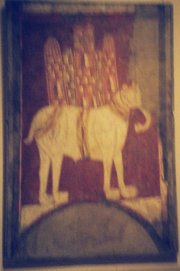Romanesque architecture
|
|
St_michaelis.jpg
The name Romanesque, like many other stylistic designations, was not a term contemporary with the art it describes but an invention of modern scholarship to categorize a period. The term "Romanesque" attempts to link the architecture, especially, of the 11th and 12th centuries in medieval Europe to Roman Architecture based on similarities of forms and materials. Romanesque is characterized by a use of round or slightly pointed arches, barrel vaults, cruciform piers supporting vaults, and groin vaults. The great carved portals of 12th century church facades parallel the architectural novelty of the period—monumental stone sculpture seems reborn in the Romanesque.
Romanesque seems to have been the first pan-European style since Roman Imperial Architecture and examples are found in every part of the continent. One important fact pointed out by the stylistic similarity of buildings across Europe is the relative mobility of medieval people. Contrary to many modern ideas of life before the Industrial Revolution, merchants, nobles, knights, artisans, and peasants crossed Europe and the Mediterranean world for business, war, and religious pilgrimages, carrying their knowledge of what buildings in different places looked like. The important pilgrimage routes to Santiago de Compostela in Galicia, modern north east Spain, may have generated as well as spread some aspects of the Romanesque style.
| Contents |
Surviving Romanesque buildings
Listed below are examples of surviving Romanesque buildings in modern France, Germany, Spain, Ireland, Italy, England, Netherlands, Scandinavia and Central Europe.France
Romanesque_church_inside,_Saint-Saturnin,_Auvergne,_France.jpg
- Saint-Foy, Conques
- Saint-Sernin, Toulouse
- Saint-Bénigne, Dijon
- Notre-Dame-du-Port, Clermont-Ferrand
- Saint-Austremoine, Issoire
- Notre-Dame, Orcival
- Saint-Nectaire
- Saint-Saturnin
- Saint-Pierre, Angoulême
- Saint-Trophime, Arles
- Sainte-Madeleine, Vezelay
- Sainte-Croix, Bordeaux
Jumièges.jpg
- Paray-le-Monial
- Saint-Front, Perigueux
- Notre-Dame-la-Grande, Poitiers
- Saint-Savin-sur-Gartempe
- abbey church, Cluny
- Chapaize
- Abbatiale de Cruas
- Abbey of Vigeois, Limousin
- Tour Fenestrelle, Uzès
- Fontevrault
- Autun
- Normandy :
- Sant Martí del Canigó, Roussillon
Germany
- Mainz, St. Martin - Mainz Cathedral
- Saint Michaelis and cathedral in Hildesheim
- Cologne, St. Maria im Kapitol
- Maria Laach, Benedictine church
- Osnabrück Cathedral
- Trier Cathedral
Spain

- Leon Cathedral
- Ripoll
- Salamanca Cathedral
- San Juan de la Peña
- Sant Climent de Taüll, Vall de Boí
- Sant Miquel de Cuixà, Empordà, Catalonia
- Santiago de Compostela
- Cathedral, Ourense, Romanesque and Gothic
- The 20 romanesque churches of Segovia
- Tarragona Cathedral Cloister
- Zamora
Ireland
- Cormac's Chapel, Cashel (1127-1134)
- Aghadoe, County Kerry (1158)
- Nuns' Church, Clonmacnoise (1167)
- Tuam Cathedral and Crosses (c. 1184)
- Ardmore Church and Round Tower, County Waterford
- Baltinglass Cistercian Abbey, County Wicklow
- Boyle Cistercian Abbey, County Roscommon
- Christ Church Cathedral, Dublin
- Clonfert Cathedral, County Galway
- Cong Abbey, County Galway
- Devenish Round Tower and Churches, County Fermanagh
- Dysert O'Dea Church and Round Tower, County Clare
- Freshford, County Kilkenny
- Jerpoint Cistercian Abbey, County Kilkenny
- Killeshin, County Laois
- Maghera, County Derry
- Monaincha Abbey and Cross, County Tipperary
- Rahan Church of Ireland Church, County Offaly
- Timahoe Round Tower, County Laois
- St. Saviour's, Glendalough
Italy
- Sant' Ambrogio, Milan
- San Zeno, Verona
- Cathedral in Pisa
- San Michele, Pavia
- San Miniato al Monte, Florence
- Cathedral in Cefalu
- Cathedral in Monza
England
In England, Romanesque architecture is often termed 'Norman architecture'.
- Crypt of Canterbury Cathedral
- Durham Cathedral
- Hereford Cathedral
- Kilpeck Church, Herefordshire
- Leominster Cathedral
- Ludlow Castle
- Peterborough Cathedral
- Southwell Cathedral
Netherlands
- Sint Servaas, Maastricht
- Onze-Lieve-Vrouwe, Maastricht
- Munsterkerk, Roermond
- Janskerk, Utrecht
- Pieterskerk, Utrecht
- St. Plechelmus, Oldenzaal
- Chapel, Lemiers
- Reformed church, Oirschot
Belgium
Scandinavia
Central Europe
- S. George, Prague (Czech Republic)
- rotunda of St. George in The Říp Mountain (Czech Republic)
- abbey church, Jak (Hungary)
- Belapatfalva church (Hungary)
- S. Andreas, Krakow (Poland)
See also
External links
- Corpus of Romanesque Sculpture in Britain and Ireland (http://www.crsbi.ac.uk)
- Illustrated history (French) (http://correzeromane.free.fr/notice.php?nom=Vigeois)
- Overview of French Romanesque art (http://www.art-roman.net)
da:Romansk stil de:Romanik es:Arte románico eo:Romaniko fr:Architecture romane he:ר××× ×¡×§ ja:ロマネスク建築 nl:Romaanse stijl pl:Architektura romańska pt:Estilo românico sv:Romansk arkitektur
